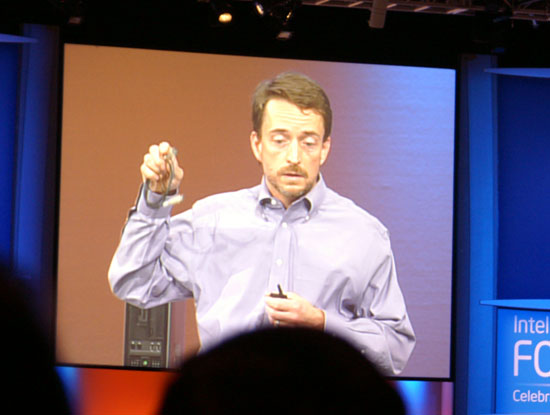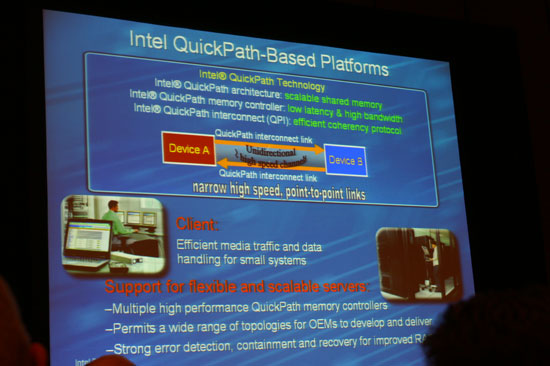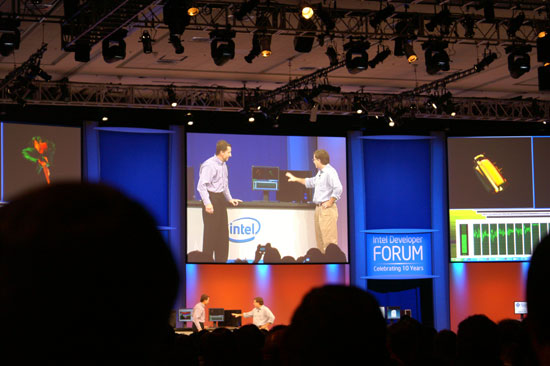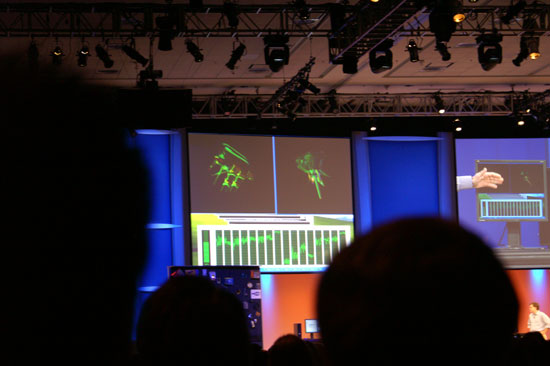Intel Developer Forum 2007 - Day 1: More Nehalem, Penryn Announced, and Gelsinger Speaks
by Anand Shimpi & Larry Barber on September 18, 2007 8:03 PM EST- Posted in
- Trade Shows
More Nehalem
When we published today's initial coverage we gave Nehalem very short treatment, simply due to a lack of time, but now that things have slowed down a bit we can touch on the gravity of today's Nehalem demonstrations.

We've talked in the past about Intel's incredibly strong roadmap and how it's firing on all cylinders, today's demonstration is perfect indication of that. Penryn isn't even out the door yet and Nehalem is design-complete, undergoing testing and already running two major OSes according to Intel.
We've yet to lay our hands on AMD's Phenom, much less give you more than a crude set of performance expectations based on server hardware, needless to say Intel is doing to AMD, what AMD did to Intel for years while the Pentium 4 struggled to perform.
Let's say that again: Intel is showing an architecture that won't be out until the end of next year, today.
A mere four hours after the first Nehalem demo, Intel was back with another one and this one, even more impressive. Nehalem uses Intel's new QuickPath interconnect, formerly known as CSI, and a direct competitor to AMD's Hyper Transport. Doing away with the Front Side bus and implementing a point-to-point interconnect is a huge feature of Nehalem, especially for the enterprise market, and Intel's second demo showcased just that.

The second Nehalem system featured two quad-core Nehalem processors running in a two-socket system, the two sockets being connected via QuickPath.

Each quad-core Nehalem has SMT enabled, meaning each core can work on two threads simultaneously, so the entire box can simultaneously work on 16 threads as is evidenced by the obligatory task manager screenshot:


Obviously we have no performance data or clock speed information, we'd expect both to be quite low at this point but the fact that we're seeing the demo today is quite good. Despite worries of AMD being uncompetitive going forward, Intel seems to be proceeding according to plan, which is exactly what we want to see.

Nehalem will also add 7 new SSE4 instructions to its reportoire, note the diagram showing direct connections between processors and memory, very AMDesque

The Nehalem launch is a very important one for Intel as it is the first full repetition of its 2-year architectural cycle (tick-tock model); many wondered if Intel could pull it off, and we'll find out by this time next year.










8 Comments
View All Comments
GhandiInstinct - Wednesday, September 19, 2007 - link
Kurt cobain would be proud...Intel isn't getting lazy cause its on top, it's doing what a great company should do, trounce and eliminate all competition while it's customers get the cheapest and greatest technology.
GO INTEL!!!!
Now with USB3.0 even more reason to buy an ultimate rig from my AGP in 2H 2008.
DigitalFreak - Tuesday, September 18, 2007 - link
So, if it truely is 10x the performance, that would equate to 4.8Gb. Wow, who really needs ESATA then if CPU utilization is minimized? (Yes, I know ESATA will still have it's place).spinportal - Wednesday, September 19, 2007 - link
If USB 3.0 chipsets can forgo the saturation and polling deadlocking of the southbridge (data channels for SATA, IDE, USB, Ether(giga)net, PCIe bus? vs Northbridge on memory?) for competition of bandwidth, this kind of speed is worthwhile. What is the point of plugging in a USB device and lockstepping your OS's multithreading while it's negotiating? What's the point of throttling a USB channel, when your other channels tank, starve and choke?psychobriggsy - Wednesday, September 19, 2007 - link
I somehow suspect that CPU utilisation will not be minimised via "USB-offload-engines", so expect 4800Mbps USB3 to require quite a bit more CPU resources. If you want an interconnect with lower CPU utilisation, then there is always Firewire, although USB3 promises to put the freeze on that technology. Firewire needs to get its act together methinks.luxor - Tuesday, September 18, 2007 - link
Anand, these pics are blurry. You know this. We would love to be able to read some of these slides.Tristesse27 - Thursday, September 27, 2007 - link
BTW, your pictures aren't blurry because you're sitting in the back. You're pictures are blurry because you have the wrong camera for the job.rqle - Wednesday, September 19, 2007 - link
IDF is by far the most entertaining conference of them all.mattsaccount - Tuesday, September 18, 2007 - link
"Johan made us late to the keynote and we had to sit in the back."Bad Johan!